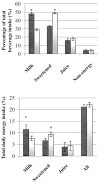Meeting calcium recommendations during middle childhood reflects mother-daughter beverage choices and predicts bone mineral status
- PMID: 15051617
- PMCID: PMC2530917
- DOI: 10.1093/ajcn/79.4.698
Meeting calcium recommendations during middle childhood reflects mother-daughter beverage choices and predicts bone mineral status
Abstract
Background: Longitudinal data regarding the influence of beverage intakes on calcium adequacy are lacking.
Objective: This study evaluated calcium intake from ages 5 to 9 y as a function of mother-daughter beverage choices and as a predictor of bone mineral status.
Design: Intakes of energy, calcium, milk, sweetened beverages, fruit juices, and non-energy-containing beverages were measured with the use of three 24-h dietary recalls in 192 non-Hispanic white girls aged 5, 7, and 9 y and their mothers. Calcium intakes from ages 5 to 9 y were categorized as either meeting or falling below recommended adequate intakes (AIs). The girls' bone mineral status was assessed with dual-energy X-ray absorptiometry at age 9 y.
Results: The mean 5-y calcium intake was related to bone mineral density at age 9 y (beta = 0.27, P < 0.001). The girls who met the AI for calcium were not heavier (P = 0.83) but had higher energy intakes (P < 0.0001) than did the girls who consumed less than the AI. Compared with the girls who consumed less than the AI, the girls who met the AI consumed, on average, almost twice as much milk (P < 0.0001), had smaller decreases in milk intake (P < 0.01), and consumed 18% less sweetened beverages (P < 0.01) from ages 5 to 9 y; the 2 groups did not differ significantly in juice and non-energy-containing beverage intakes. The girls who met the AI were also served milk more frequently than were the girls who consumed less than the AI (P < 0.0001) and had mothers who drank milk more frequently (P < 0.01) than did the mothers of the girls who consumed less than the AI.
Conclusions: These findings provide new longitudinal evidence that calcium intake predicts bone mineral status during middle childhood and reflects mother-daughter beverage choice patterns that are established well before the rapid growth and bone mineralization observed in adolescence.
Figures


References
-
- Heaney RP, Matkovic V. Inadequate peak bone mass. In: Riggs BL, Melton LJI, editors. Osteoporosis: etiology, diagnosis, and management. Philadelphia: Lippincott-Raven Publishers; 1995. pp. 115–31.
-
- Matkovic V, Ilich JZ. Calcium requirements for growth: are current recommendations adequate? Nutr Rev. 1993;51:171– 80. - PubMed
-
- Weaver CM. The growing years and prevention of osteoporosis in later life. Proc Nutr Soc. 2000;59:303– 6. - PubMed
-
- Alaimo K, McDowell MA, Briefel RR, et al. Dietary intake of vitamins, minerals, and fiber of persons ages 2 months and over in the United States: Third National Health and Nutrition Examination Survey, Phase 1, 1988–91. Adv Data. 1994;258:1–28. - PubMed
-
- US Department of Agriculture, Agricultural Research Service. Food and nutrient intakes, 1994–96, 1998. 1999. [accessed 9 September 2003]. Internet: http://www.barc.usda.gov/bhnrc/foodsurvey/products.html.
Publication types
MeSH terms
Substances
Grants and funding
LinkOut - more resources
Full Text Sources
Medical
Miscellaneous

